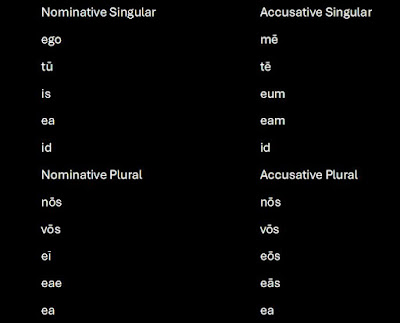Nūntius mē videt.│The messenger sees me.
Tē videō.│I see you (sg.).
Vidētisne puerum? Ita, eum vidēmus.│Do you see the boy? Yes, we see him.
Vidēsne puellam? Minimē, eam nōn videō.│Do you see the girl? No, I don't see her.
Videtne perīculum? Minimē, id non videt.│ Does he see the danger? No, he doesn't see it.
Nūntius nōs videt.│The messenger sees us.
Vōs vidēmus.│We see you (pl.)
Vidēsne puerōs? Minimē, eōs nōn videō.│Do you see the boys? No, I don't see them.
Vidētisne puellās? Ita, eās vidēmus.│Do you see the girls? Yes, we see them.
Ea vident.│They see them (=these things).
The accusative case of personal pronouns is as follows:
Nominative: ego (I) > Accusative: mē (me)
Nominative: tū (you sg.) > Accusative: tē (you)
mē: easy enough to recognise; if you're a French speaker you will immediately spot tē (Fr. te)
Nominative: is (he) > Accusative: eum (him); the same ending as 2nd declension masculine nouns
Nominative: ea (she) > Accusative: eam (her); the same ending as 1st declension feminine nouns (her)
Nominative: id (it) > Accusative: id (it); neuter nouns do not change in the accusative and neither do the pronouns
Nominative: nōs (we) > Accusative: nōs (us) i.e. exactly the same (similarly Fr. nous; no change)
Nominative: vōs (you pl.) > Accusative: vōs (you pl.) exactly the same (similarly Fr. vous; no change)
The third person plural pronouns match the endings of the nouns:
Nominative: eī (they [masc.]) > Accusative: eōs (them [masc.])
Nominative: eae (they [fem.] > Accusative: eās (them [fem.])
Nominative: ea (they [neut.]) > Accusative: ea (them [neut.]); the same rule consistently applies i.e. there is no change in the neuter nominative and accusative

No comments:
Post a Comment